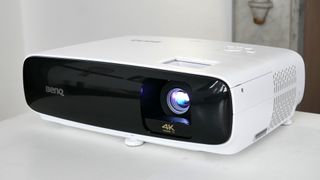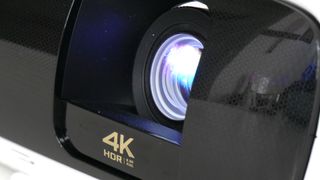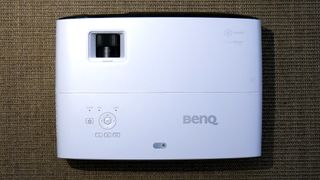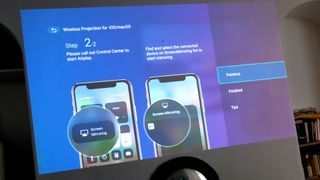TechRadar Verdict
BenQ’s new affordable 4K beamer is a multimedia workhorse thanks to wireless connectivity, streaming apps and HDR10 content support
Pros
- +
4K image precision and detail
- +
Comprehensive features, including wireless connectivity
- +
Relatively affordable
Cons
- -
Cheap optics limit your install options
- -
Relatively limited lamp life
Why you can trust TechRadar
Whisper it, but paying a premium for a business projector isn’t always necessary. Such has been the progress of mainstream projector tech, many conventional multimedia models will double up nicely as presentation and productivity machines thanks to strong brightness and a really broad feature set.
Overall: 4.5
Design: 4
Features: 4.5
Performance: 4
Usability: 5
Value: 5
That’s exactly the proposition offered by the BenQ TK810. With a lumens rating of 3,200 it offers sufficient on-paper punch for daytime usage. Meanwhile, wireless connectivity with mirroring of multiple platforms, from Android to iOS, MacOS and Windows, plus both internal storage and support for USB storage, makes a great recipe for an all round projection workhorse.

It also just so happens to support full 4K resolution courtesy of BenQ’s pixel shift tech. It’s not true native 4K, but promises most of the benefits of 4K at a fraction of the price.
Where this type of projector doesn’t quite tick the productivity box involves optics. With no lens shift and limited zoom, it lacks a little installation flexibility. To find out if that’s enough to spoil what otherwise looks like a great package, read on.

Price and availability
The BenQ TK810 can currently be had in the UK for as little as £1,049. That’s an extremely appealing price point given the 4K capability and overall feature set including wireless connectivity. It’s not currently available in the US, but should be priced around $1,200 or lower should that change.

Design and features
Designed as an all-rounder but with relatively simple optics, the BenQ TK810 casts a mid-sized shadow measuring 38cm across and nearly 13cm tall. While not truly portable, it’s certainly transportable and cuts a decent dash with its matte white chassis and glossy black fascia.
For the most part, it scores very heavily in terms of specifications. It’s a DLP model with a RGBW wheel for added brightness, the upshot of which is an ANSI lumens rating of 3,200 using a conventional High Intensity Discharge lamp. It’s rated at 4,000 hours in normal mode or up to 15,000 hours in smart eco mode. At this price point, a High Intensity Discharge lamp with a relatively short lifespan is arguably a given. But it’s worth factoring in an expectation for lower cost LED and laser projectors in the coming years.

While not a native 4K model, the BenQ TK810 sports BenQ’s clever XPR tech which imperceptibly ‘shifts’ the 1080p DLP chip’s output four times each frame to deliver the full eight million pixels of 4K. This approach to so-called pixel shifting is claimed to be superior to the two-position diagonal shifting of some LCD projectors. As you’ll see, we broadly go along with that.
However, we would prefer BenQ was more up front about the specific 4K solution offered here. BenQ’s main product webpage makes absolutely no mention of either pixel shifting in general or its specific XPR solution. That’s a bit naughty.

Less ambiguous are the other connectivity and multimedia features. The BenQ TK810 comes bundled with a WiFi dongle and ready to connect wirelessly to Android and iOS devices, plus Apple Mac and Windows PCs. It also supports media playback from both external storage via USB and 4GB of internal storage.
Projection type DLP
Resolution 3,840 x 2,160
Lamp type High Intensity Discharge
Lamp life 4,000 to 15,000 hours
Brightness lumens 3,200
Throw ratio 1.48 to 1.62
Zoom 1.1x
Lens shift N/A
Inputs HDMI 2.0b x2, USB, WiFi, RS232
Outputs 3.5mm audio S/PDIF
Dimensions 380 x 127 x 263mm
Weight 4.2kg
Yet another source of content, albeit likely less relevant for most businesses is Aptoide TV app support. Still, it adds another string to the TK810’s bow and makes for a projector that can display a wide range of content without the use of a source device.
Rounding out the multimedia features are HDR10 content support and 3D functionality. The former is handy for accurate representation of the latest media. The latter is probably more of a fringe use case.
Anyway, all of the above is controlled by a handy IR remote and leaves just one significant aspect of the BenQ TK810 to discuss, its optics. Not only do they entirely lack lens shift of any kind. The lens system is also limited to a zoom ratio of just 1.1x and a throw ratio of 1.48 to 1.62. For the record, that translates into an image size of 100 inches at a projection distance of 3.29 metres.

Performance
The BenQ TK810 is every bit as bright and punchy as you would hope for a 3,200 lumens model. While the absolute best results for daytime presentations with high ambient light levels arguably requires a brightness of 5,000 lumens or more, a projector offering that level of brightness that can also match the rest of the TK810’s features including 4K support will be very big money indeed. In the context of the accessible pricing, the brightness is more than acceptable and allows for comfortable and clear viewing in suboptimal conditions.
Speaking of clarity, BenQ’s 4K XPR pixel shifting technology is a definite step up on the single-step pixel shift alternative from some LCD projector makers. The results are much more detailed and sharp. Is it as good as a true native 4K beamer? No. The pixel definition is just a little fuzzy by comparison. As a consequence, albeit only on really close inspection, fonts are just a little aliased.

In practice, it’s barely perceivable. If precision and detail are critical for your presentations, this is an extremely cost effective way to achieve that 4K experience. 4K video content in particular looks stellar and awfully close to a native 4K model for overall detail. Colours are natural and convincing at default settings, which makes for easy initial installation. All but the most colour-accuracy demanding applications are covered.
Sticklers for image quality will notice the slight light frame border around the image that’s indicative of the underlying 0.47-inch 1080p DLP chip that powers this device. But noise levels, if you are wondering, are eminently tolerable. Silent it is not, but nor will it distract from presentations or media playback.

The broader feature set generally works well, too. The BenQ TK810 offers a comprehensive and slick on-screen menu that makes accessing all the extras extremely easy. Hooking up wirelessly via an Android or iOS smartphone takes seconds. Ditto connecting a MacBook or Windows laptops, provided the latter has the Chrome browser installed. That said, it’s worth noting the limitations of the wireless interface in terms of frame rates. In our testing across multiple devices, the frame rate was not good enough for smooth video playback. For more static presentations, the wireless option works just fine.
As for playing back media from external and internal storage, compatibility with a wide range of media files, including 4K content encoded in H.265 proved flawless in our testing. App functionality was a little more patchy, with the new Disney+ app failing to launch. But that probably reflects buggy third party code more than any failure on BenQ’s part.

If that’s the good news, less impressive are this projector’s optics. The combination of a lack of lens shift, plus the limited zoom makes the TK810 a little inflexible in terms of installation. It will need to be located quite precisely to achieve a given size of image with the correct geometry. It also needs a fair bit of distance from the wall to create a large image. The relatively cheap optics likewise mean truly perfect geometry can’t quite be achieved, meanwhile nailing perfect focus across the whole image is rather finickity, too.
Verdict
As an all-round workhorse with some impressive 4K chops, the BenQ TK810 is very impressive at the price. It will hook up to almost any device you can throw at it, with both wireless and wired options. The other interface and media playback options, including USB and built-in app support, only add to the overall flexibility and usability.
The image quality is impressive at this price point and comes very close to native 4K for detail and precision. The same goes for the TK810’s brightness levels, which get the job done even in suboptimally bright conditions.
The BenQ TK810’s chief weakness, then, comprises its optics. The lack of lens shift and limited zoom limit your installation options, while the relatively cheap lens system prevents perfect geometry.
However, provided you don’t need a short throw projector and will generally be able to situate this projector centrally in your chosen display location, those shortcomings shouldn’t be deal breakers on what is otherwise one heck of a beamer at this price point. It’s capable, flexible and oh-so usable. Add in those 4K visual fireworks and it's a very strong package - the sort of beamer that you’d better keep a close eye on for fear of staff pinching it at the weekend.
- We've also featured the best monitors.
Technology and cars. Increasingly the twain shall meet. Which is handy, because Jeremy (Twitter) is addicted to both. Long-time tech journalist, former editor of iCar magazine and incumbent car guru for T3 magazine, Jeremy reckons in-car technology is about to go thermonuclear. No, not exploding cars. That would be silly. And dangerous. But rather an explosive period of unprecedented innovation. Enjoy the ride.


